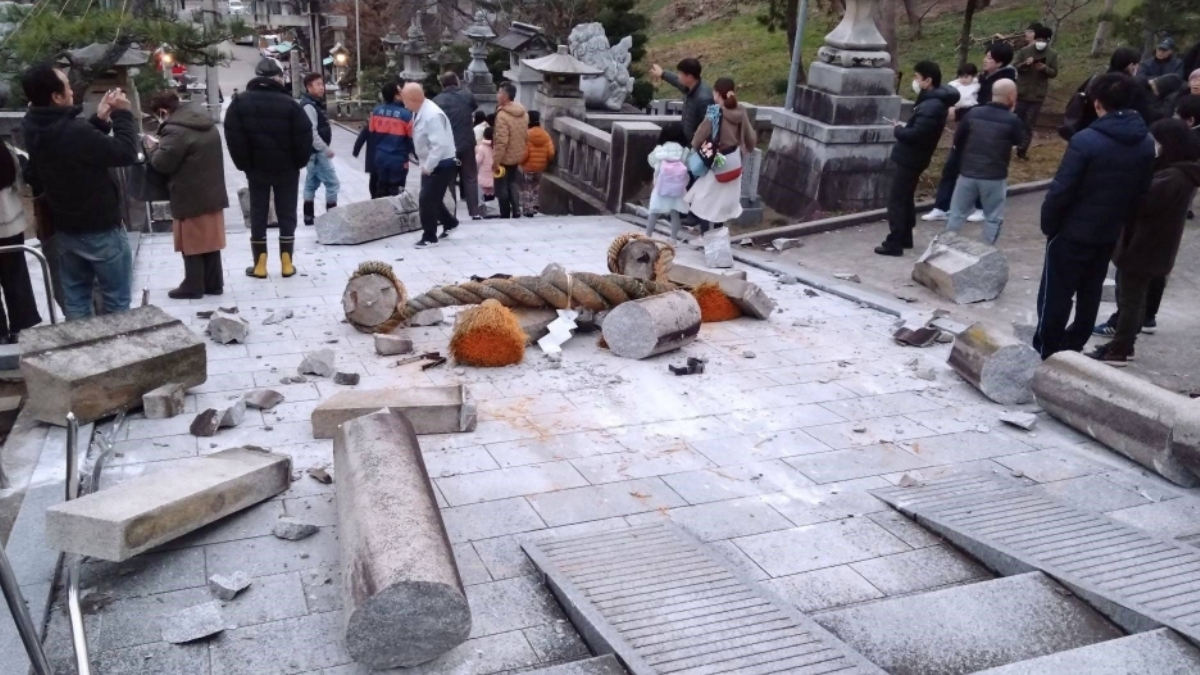Japan experienced a series of powerful tremors on New Year’s Day, with at least 30 casualties and significant damage. The seismic activity included a 7.6-magnitude earthquake and over 150 aftershocks, contrasting the global celebration of the beginning of 2024 with Japan’s unfortunate natural disaster.
Table of Contents
Differing reports on the quake’s magnitude emerged, with the US Geological Survey citing 7.5, while Japan’s meteorological agency measured it at 7.6. The relentless shaking, including a 5.6 magnitude jolt, left a trail of destruction in its wake.
Initially, there were no reports of damage from the calamity, but as time passed, accounts of devastation began to surface. When Tuesday dawned, Ishikawa revealed the true scale of the disaster – buildings smoldering, houses flattened, and fishing boats either sunk or washed ashore.
The seismic event on January 1, 2024, unleashed tsunami waves reaching over a meter high, causing havoc with damaged homes and igniting a massive fire that wrought destruction throughout the night.
Addressing the nation, Prime Minister Fumio Kishida expressed the profound impact of the earthquakes, stating, “Extensive damage with numerous casualties has been caused.”
He went on to elaborate, emphasizing, “The confirmation of very extensive damage includes numerous casualties, building collapses, and widespread fires.” The gravity of the situation became increasingly apparent as the Prime Minister highlighted the multifaceted consequences of this tragic event.

Significant landslide in Nanao City
NHK has released a report indicating the occurrence of a significant landslide in Nanao City, with aerial footage revealing multiple areas now characterized by exposed mountain surfaces devoid of vegetation. The massive landslide is presumed to have taken place on the slopes of a mountain in the region, capturing the attention and concern of local authorities and residents alike.
500 individuals stranded at the airport
According to the NHK report, around 500 individuals find themselves stranded in a parking lot at Noto Airport as a result of the recent earthquakes. A land ministry official mentioned that they are currently waiting in buses and other vehicles since the airport’s terminal building suffered significant damage.
Despite their challenging situation, efforts are being made to provide them with essential supplies like food and blankets. Unfortunately, the nearby roads are impassable due to the tremors, making the situation more complicated. Notably, the runway itself bears the impact with several cracks, some stretching up to 10 meters. Adding to the complexity, officials have declared that the airport will remain closed until at least Thursday.
The reason behind this extended closure is the difficulty repair workers are facing in reaching the facility. The damage to the roads hampers their ability to provide the necessary repairs promptly, leaving those stranded at Noto Airport in a state of uncertainty.
Bullet train in central Japan stuck for hours
Four high-speed trains in central Japan were stuck for around 11 hours because of a powerful earthquake. The trains, called Hokuriku Shinkansen, got to the stations after the service was stopped when the earthquake hit on Monday at 4:10 pm. Approximately 1,400 passengers were left stranded. Thankfully, the trains had power, working air conditioners, and the train staff brought food to the passengers using cars.
China is willing to provide aid to Japan in dealing with the Earthquake
China has expressed its readiness to extend necessary support to Japan following the massive earthquake that shook the country on New Year’s Day, as conveyed by the Chinese foreign ministry on Wednesday (January 03rd).
During a routine press briefing, Wang Wenbin, the spokesperson for the ministry, reassured that there were no reported Chinese casualties resulting from the earthquake. In response to queries about an airplane collision at Tokyo’s Haneda airport the previous day, Wang stated that no Chinese citizens were harmed in the incident.
Notably, Japan had not sought assistance from China in this regard. Providing additional details, Wang mentioned that the Chinese embassy in Japan had reached out to the 14 Hong Kong tourists who were on the Japan Airlines plane involved in the collision.
The collision, which raised concerns about runway safety, resulted in the tragic loss of five out of the six crew members on the smaller De Havilland Dash-8 Coast Guard turboprop. However, there was a silver lining as all 379 individuals aboard the Japan Airlines Airbus A350 emerged unharmed from the incident.

The seismic event on January 1, 2024, unleashed tsunami waves reaching over a meter high, causing havoc with damaged homes and igniting a massive fire that wrought destruction throughout the night.



